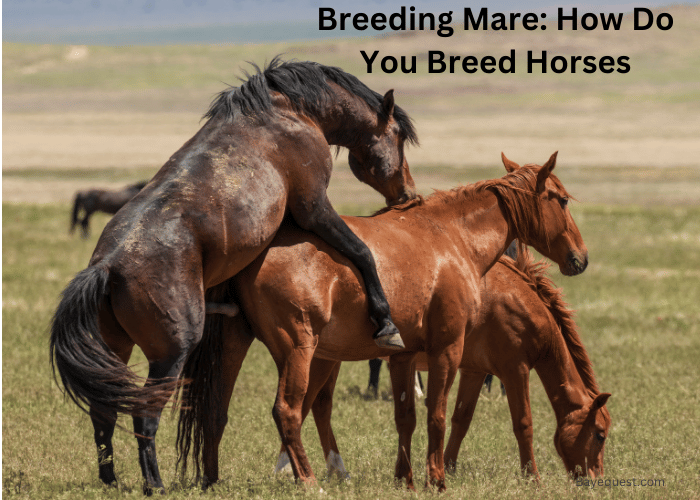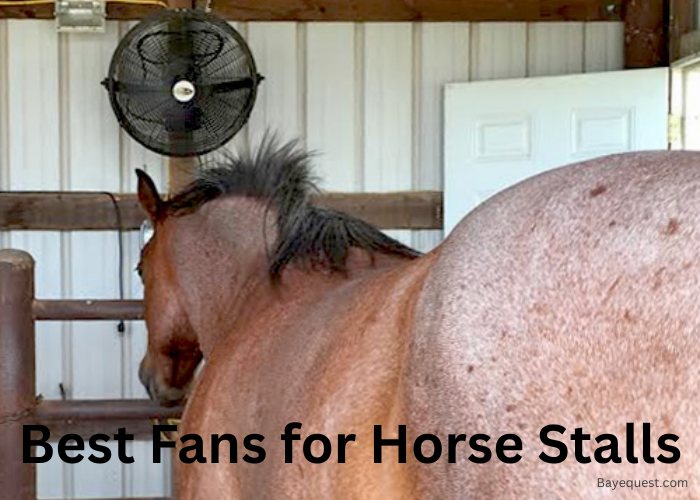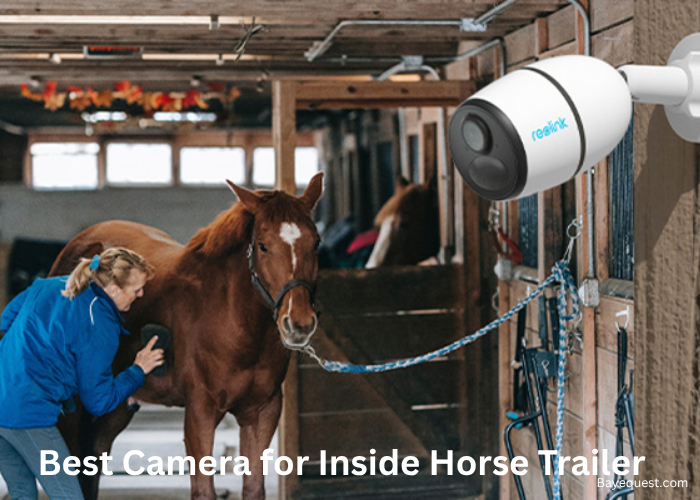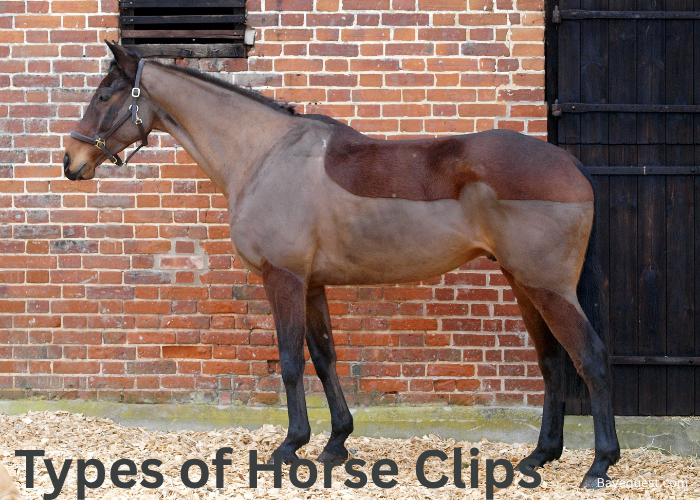Breeding horses isn’t just an art; it’s a science where every decision can influence generations. With over two decades in the equine breeding industry, my journey has unveiled the intricate dance of genetics, timing, and care essential for success.
If you’re navigating the complexities of breeding your mare, this article is your compass.
From selecting the right stallion to understanding the nuances of mare care, we’ll guide you through each step.
Breeding Mare: How Do You Breed Horses? Key Takeaway
To breed horses, use natural, pasture, hand mating, or artificial insemination. In pasture mating, stallions mate freely with mares. Hand mating involves controlled breeding under supervision. Artificial insemination uses collected semen inserted into the mare. Breed registry rules for artificial insemination differ, ensuring genetic standards and horse health.
Roles of Stallion in Horse Breeding
Stallions play a key role in horse reproduction. They are the male horses that mate with mares, the female horses.
The mating process starts with the stallion showing interest in the mare. He does this by sniffing and nuzzling her.
If the mare is ready to mate, she will show signs of being in heat. This means she’s ovulating and can get pregnant.
The stallion will then mount the mare. This is called mating or covering.
During this process, the stallion ejaculates semen into the mare’s reproductive tract. The semen contains sperm, which can fertilize the mare’s eggs.
After mating, the mare’s body takes over. If the sperm successfully fertilizes an egg, the mare becomes pregnant. The stallion’s job is done at this point.
In some cases, breeders use artificial insemination. This means they collect semen from the stallion and manually insert it into the mare. This method can be more controlled and safer for both horses.
Stallions are also chosen for breeding based on their genetics, health, and behavior. Good genes can produce strong, healthy foals. A stallion’s behavior is important too. A calm and well-mannered stallion is easier to handle during the breeding process.
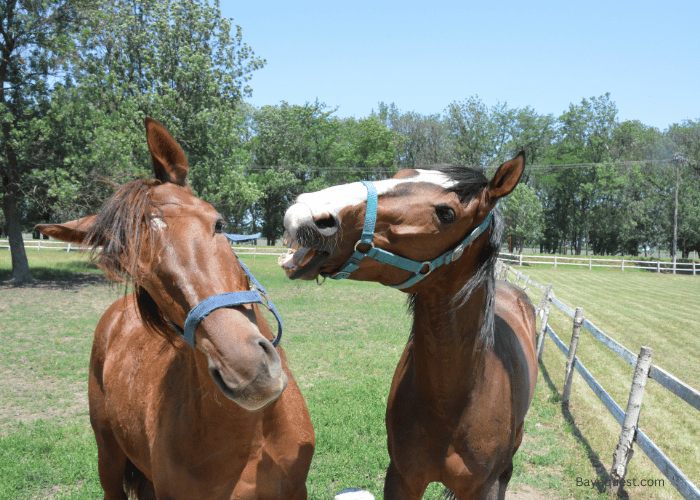
Methods of Horse Mating
Horse mating can occur in several different ways. The most common methods are natural mating and artificial insemination.
Natural Mating
In natural mating, the stallion and the mare are brought together. The stallion shows interest by sniffing and nuzzling the mare.
If the mare is in heat and ready to mate, she will stand still for the stallion. The stallion mounts the mare and ejaculates semen, which fertilizes the mare’s eggs.
This is the most traditional and straightforward method.
Artificial Insemination
In artificial insemination, breeders collect semen from the stallion. This can be done using a dummy mare or special equipment.
The semen is then checked for quality and, if needed, cooled or frozen for storage. When the mare is ready to mate, the semen is thawed and carefully inserted into her reproductive tract using a syringe or similar tool.
This method allows for more control and can be safer for the stallion and the mare.
Pasture Mating
Another method is pasture mating. This method keeps the stallion and several mares together in a pasture.
The stallion mates with the mares naturally, without human intervention. This method is less controlled but can be more natural for the horses.
Hand Mating
Hand mating is a more controlled version of natural mating. Handlers bring the stallion and mare together, ensuring the process is safe and efficient.
The handlers can intervene if there are any issues, making it a safer option than pasture mating.
How to Manage Your Broodmare Well
Breeding horses isn’t just about putting a mare and stallion together. It’s a specific part of vet care focused on helping horses reproduce.
Even if your mares and stallions are healthy, there’s no guarantee they’ll have a foal. It’s especially true for first-time mares, older ones, or those who find it hard to get pregnant.
Working closely with a vet and following a plan for each mare can help improve your chances of adding a new foal to your stable in the spring.
See also: Difference Between Mare and Filly.
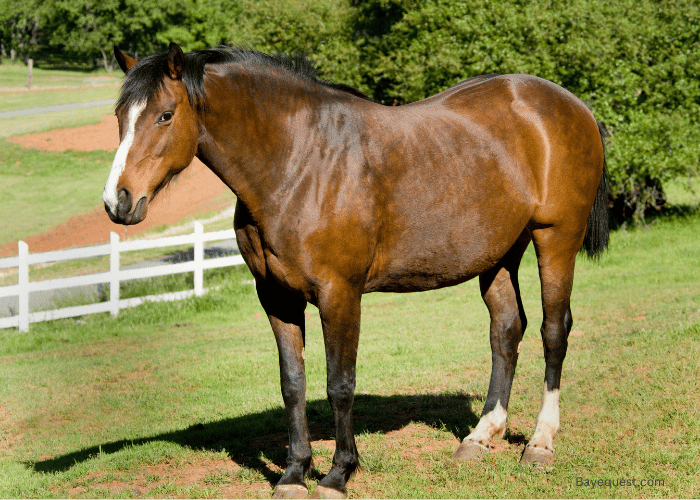
8 Steps for Breeding of Horses
Learn the essential process with these 8 steps for breeding your mare, ensuring a successful and healthy foal.
Step 1: Checking the Mare’s Health Before Breeding
Start by making sure the mare is healthy. Check if her hooves are in good shape, if she’s up to date on shots, and if she has any parasites by doing a faecal egg count.
Also, see if she’s at the right weight and needs any dental work.
Broodmares need a Body Condition Score (BCS) between 5 and 7 before being bred. You should be able to feel the mare’s ribs but not see them. Look for health issues like PPID or insulin problems that might make breeding harder.
Go over the mare’s history of getting pregnant, any uterus issues, or times she didn’t stay pregnant.
For live cover breeding, check what the breeding place requires. They might want your mare vaccinated against certain diseases like rhinopneumonitis to keep the stallion safe. Keep her vaccinations up to date, even when she’s pregnant.
To lower the chance of the mare losing the baby, the experts recommend giving her a vaccine against herpesvirus-1 at five, seven, and nine months into the pregnancy.
On farms where many horses are bred, they might vaccinate even more often, but that’s not the usual way to do it.
Step 2: Conducting a Breeding Soundness Exam
Breeding a mare involves close collaboration between the owner and the vet. A crucial step in this process is the breeding soundness exam, which vets perform to identify and address any issues before breeding.
Consider your budget and discuss with your vet the various tests available. Sometimes, a mare may only need a thorough breeding soundness exam after failing to conceive after several attempts.
This evaluation is particularly critical for mares who have difficulty conceiving or are older. Its purpose is to pinpoint problems or provide insights, enabling the owner to make well-informed decisions.
For mares without known breeding issues, the vet begins by examining the reproductive anatomy, paying special attention to the perineal conformation.
Poor perineal conformation increases the risk of contamination, which can be mitigated by procedures like Caslick’s, where the vulvar lips are sutured together and then opened for breeding and foaling.
The exam also assesses the mare’s oestrous cycle and examines her ovaries using transrectal palpation and ultrasound. These techniques can detect uterine or vaginal abnormalities, such as excessive fluid indicating inflammation or inadequate uterine clearance.
Ultrasound exams are standard practice, offering a detailed view that aids in managing the breeding process. It’s essential for understanding the mare’s reproductive health and guiding further testing.
Mares with a history of reproductive challenges, including those with “baggy, saggy” uteruses, often undergo additional tests to evaluate for inflammation and infection.
This is especially true for older mares who have birthed multiple foals or have had previous uterine inflammation, as they may face higher risks of post-breeding inflammation.
A uterine lining biopsy can reveal conditions like inflammation, scar tissue, and enlarged lymph vessels. This test allows the vet to assess the mare’s chances of conceiving and carrying a pregnancy to term.
In cases requiring further investigation, a hysteroscopic exam may be performed. This involves using a small camera to inspect the uterus for abnormalities such as foreign bodies, scars, or microbial growth.
The insights gained from the breeding soundness exam enable the vet to recommend specific management practices or treatments to optimize the mare’s chances of successful breeding.
Step 3: Getting the Horse for Breeding Ready
After your vet takes care of any breeding issues, you must check that your mare is ready to breed. Most mares are ready in the warmer months, but some can be ready anytime.
Some breeders, like those in horse racing, aim to have their mares give birth early in the year. To do this, they get their mares to start their cycle in winter when they normally wouldn’t. Using special lights or hormone treatments can help kickstart this process.
When the days get longer, or we use artificial light or hormones, the mare’s body reduces melatonin. This change triggers the release of a hormone called GnRH. GnRH tells the brain to make two other hormones, FSH and LH, that help the ovaries prepare.
The mare’s ovaries will keep making and losing small egg pouches called follicles until one big one takes over. This big one produces enough of a hormone called estrogen to start the mare’s breeding cycle.
Then, LH makes this big follicle release its egg. This process moves the mare from not being in the cycle to starting her cycle, usually taking about 60 days to get to the first ovulation.
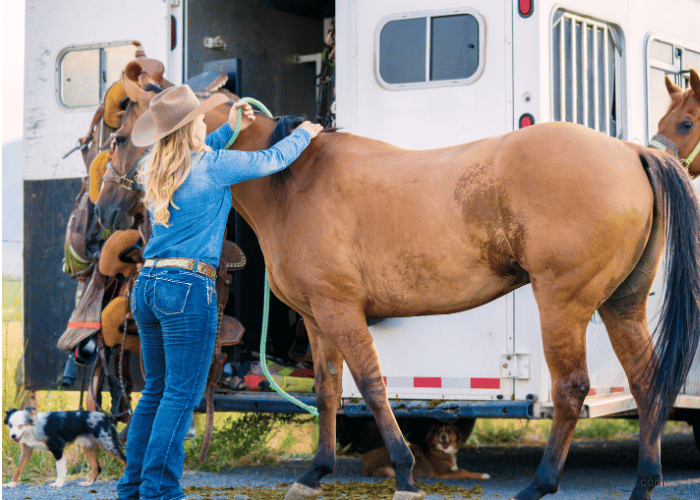
Step 4: Monitoring the Mare’s Estrous Cycle
The mare’s estrous cycle lasts about 21 days, with a fertile period of five to seven days early. The critical moment for breeding, ovulation, occurs in the final 24 to 36 hours of this fertile window.
Aiming to breed as close to ovulation as possible is key to increasing the chances of successful conception.
Knowing when a mare is in heat is essential for planning the timing of breeding, whether naturally or through artificial insemination (AI). Observe her behaviour around a teasing stallion to identify when a mare is ready.
Indications of the mare in heat include interest in the stallion, vulvar winking, adopting a breeding stance, lifting her tail, and frequent urination.
On the other hand, a mare not in heat may pin her ears back, clamp her tail down, act aggressively, or ignore the stallion entirely.
Step 5: Choosing the Right Time to Breed Your Mare
After your mare starts her cycle, it’s time to pick when to breed her. It’s usually better to wait for later heats than the first one because they often lead to higher chances of pregnancy.
If you’re breeding a racehorse, you’ll probably want the foal born near January 1.
Whether you choose live cover or artificial insemination (AI) affects your timing:
- Fresh semen: This is most effective but must be used immediately.
- Cooled semen: This can last about 36 to 48 hours, so you should aim to have the mare ready to ovulate about 24 to 40 hours after you inseminate her.
- Frozen semen: This is the hardest time, right? You need to do the insemination within six hours before or after she ovulates, which can be a bit tricky and might not work as well.
Using cooled semen means you need to know when the stallions are collected and how the semen is sent—like by plane or overnight shipping. This helps you line up the insemination with the mare’s ovulation time, making sure everything’s ready when the semen arrives.
Step 6: Syncing Breeding Time with Ovulation Using Vet Techniques
If you’re looking to get a mare pregnant quickly or just want to keep track of her cycle, your vet can use a trick called “short-cycling.” This is useful if you’re breeding her again right after she’s had a foal.
The vet gives her a special medicine that makes her ready to breed sooner than usual, reducing the waiting time, which normally lasts about 14 to 17 days.
How soon she’s ready depends on how big the egg-carrying part (follicle) is when she gets the medicine, usually about six days after the egg is released.
- If the follicle is about 25mm, she’ll be ready to breed in four to five days, and then it takes another three to four days for her to release an egg.
- If the follicle is bigger, like 35mm, she’ll be ready in two to three days, and will release an egg in another two to three days after that.
There’s also a way to make sure she releases an egg right when you want her to. This involves giving her another kind of medicine. Think of it as a way to make sure everything goes as planned.
Once she starts showing signs of readiness, it’s good to check on her often. The more you look, the better you’ll understand her cycle.
For mares that need special timing, like when using frozen semen, you might even check three times a day to learn exactly when the best time to breed is.
When you know the best time to breed, have your vet take care of the breeding through natural or artificial insemination. If the vet notices any fluid in her uterus, it might mean a problem needs looking into.
Read: The Most Expensive Quarter Horse
Step 7: Helping Mares Clean Out After Breeding
After breeding, a mare’s body removes stuff it doesn’t need, like dead sperm and other debris. Usually, nature takes care of this, especially if a mare breeds a few times.
But, when we breed horses in a controlled way, sometimes this natural cleanup doesn’t work as well. This can cause inflammation if the mare’s body doesn’t contract right or if the cervix doesn’t open properly to let fluids out.
Mares that have had many foals might have a harder time with this cleanup. Their uterus can sag, making it tough for fluids to get out because of gravity.
Younger mares don’t usually have this problem because their uterus is better positioned to clear things out.
Moving around helps mares clean out naturally after breeding. If needed, giving medicine like oxytocin, doing a special cleaning called uterine lavage, or even acupuncture can help the uterus contract and clean out.
For mares that have a hard time because their cervix won’t relax, there are medicines to help with that, too. This is really helpful for older mares or those that haven’t had foals and have a tight cervix.
Step 8: Confirming Pregnancy
Once your mare has been bred, the crucial next step is to find out if she’s pregnant. Around 14 to 15 days after she ovulates, your vet can perform an ultrasound to see if the breeding was successful.
If the mare isn’t pregnant, your vet will investigate why. Understanding why can help fix problems, preparing everything for another breeding attempt.
Interesting read: Why horses roll on the ground.
How to Breed a Horse: Conclusion
In horse breeding, patience, knowledge, and a deep respect for the process define the path to success.
Our journey through the nuances of equine reproduction reveals that blending science with intuition leads to the most rewarding outcomes.
Whether you’re a seasoned breeder or just beginning, remember that every mare and stallion brings unique traits to the lineage they create. Embrace the challenges, celebrate the victories, and always prioritize the well-being of your horses.
Armed with the insights shared, you’re now better equipped to embark on your breeding endeavors with confidence and a sense of purpose. Forge ahead, and may your passion for horse breeding flourish.
Next, let’s explore an essential part of the process: the mare’s gestation period, how long it lasts, what to expect, and how to support her every step of the way.




